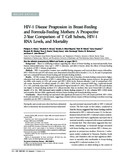| dc.contributor.author | Otieno, Phelgona A | |
| dc.contributor.author | Brown, Elizabeth R | |
| dc.contributor.author | Mbori-Ngacha, DA | |
| dc.contributor.author | Nduati, RW | |
| dc.contributor.author | Farquhar, Carey | |
| dc.contributor.author | Obimbo, Elizabeth M | |
| dc.contributor.author | Bosire, Rose K | |
| dc.contributor.author | Emery, Sandy | |
| dc.contributor.author | Overbaugh, Julie | |
| dc.contributor.author | Richardson, Barbra A | |
| dc.contributor.author | John-Stewart, Grace C | |
| dc.date.accessioned | 2013-02-25T14:34:34Z | |
| dc.date.issued | 2007 | |
| dc.identifier.citation | The Journal of infectitious diseases | en |
| dc.identifier.uri | http://erepository.uonbi.ac.ke:8080/xmlui/handle/123456789/11234 | |
| dc.identifier.uri | http://www.ncbi.nlm.nih.gov/pubmed/17191167 | |
| dc.identifier.uri | http://www.ncbi.nlm.nih.gov/pmc/articles/PMC3394541/ | |
| dc.description.abstract | Background. There is conflicting evidence regarding the effects of breast‐feeding on maternal mortality from human immunodeficiency virus type 1 (HIV‐1) infection, and little is known about the effects of breast‐feeding on markers of HIV‐1 disease progression.
Methods. HIV‐1-seropositive women were enrolled during pregnancy and received short‐course zidovudine. HIV‐1 RNA levels and CD4 cell counts were determined at baseline and at months 1, 3, 6, 12, 18, and 24 postpartum and were compared between breast‐feeding and formula‐feeding mothers.
Results. Of 296 women, 98 formula fed and 198 breast‐fed. At baseline, formula‐feeding women had a higher education level and prevalence of HIV‐1-related illness than did breast‐feeding women; however, the groups did not differ with respect to CD4 cell counts and HIV‐1 RNA levels. Between months 1 and 24 postpartum, CD4 cell counts decreased 3.9 cells/μL/month (P<.001), HIV‐1 RNA levels increased 0.005 log10 copies/mL/month (P=.03), and body mass index (BMI) decreased 0.03 kg/m2/month (P<.001). The rate of CD4 cell count decline was higher in breast‐feeding mothers (7.2 cells/μL/month) than in mothers who never breast‐fed (4.0 cells/μL/month) (P=.01). BMI decreased more rapidly in breast‐feeding women (P=.04), whereas HIV‐1 RNA levels and mortality did not differ significantly between breast‐feeding and formula‐feeding women.
Conclusions. Breast‐feeding was associated with significant decreases in CD4 cell counts and BMI. HIV‐1 RNA levels and mortality were not increased, suggesting a limited adverse impact of breast‐feeding in mothers receiving extended care for HIV‐1 infection. | en |
| dc.language.iso | en | en |
| dc.relation.ispartofseries | 195: 220-9 (15 January); | |
| dc.title | HIV-1 disease progression in breast-feeding and formula-feeding mothers: | en |
| dc.title.alternative | a prospective 2-year comparison of T cell subsets, HIV-1RNA levels, and mortality | en |
| dc.type | Article | en |
| local.publisher | Department of Pediatrics, University of Nairobi, Nairobi, Kenya | en |


